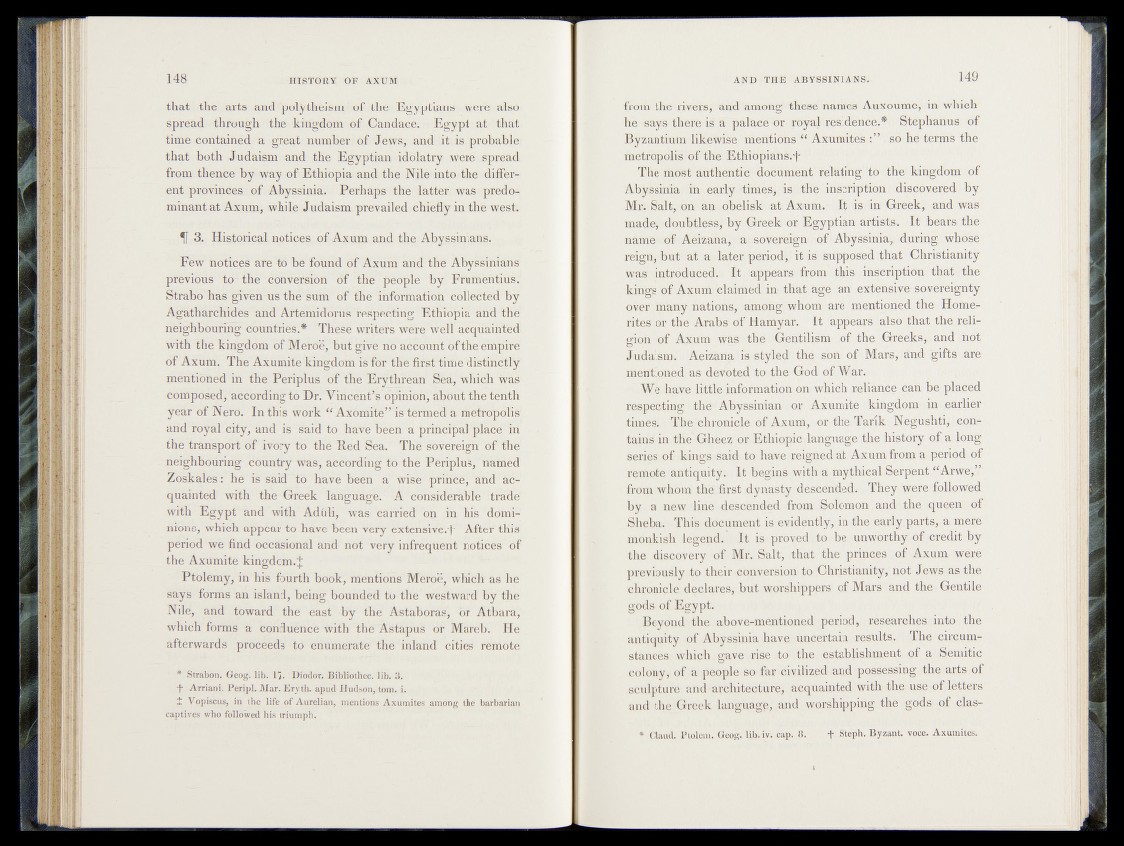
that the arts and^potytheismiof the
spread through the kingdom of Candace.: - Egypt at that
time contained a great numbeG of Jews, and it is probable'
that both: Ju daism and the Egyptian idolatry were spread
from thence by way of Ethiopia and;, the Nile into the different
provinces of Abyssinia. Perhaps the latter was predominant
at Axum, while Judaism prevailed chiefly in the west.
3. Historical notices of Axum and the Abyssinians.
Few notices are Oo be found Of Axum and the Abyssinians
previous to- the conversion of the people by FrumentiuSv
Strabo has given us the sum of the information collected* by
Agatharehides and Artemidorus respecting Ethiopia and the;
neighbouring countries.* These writers werewell acquainted
with the kingdom of Meroe, but give rib account of the Empire
of Axum. The Axumite kingdom is for the first time distinC'fly’
mentioned in the Periplus of the Erythrean Sea', which was
cbmposed, according to Dr. Vincent’s opinion, about fhef Cnth
year of Nero. In this work ¥ Axomite’’ is termed a metropolis^
and royal city, and is "said to have been a principal'plaee^Tn
the transport of ivory to the Red Sea. The sovereigbr of fheJ
neighbouring country Was, according to the Periplus, 'named
Zoskales: he is said to have been a wise |)rinhei and ^acquainted
with the Greek language. A considerableHtfdde*
with Egypt and with Aduli, was carried orr in his dominions,
which appear to have been very extensive.!* After this
period we find occasional and not very infrequent notices of
the Axumite kingdom.
Ptolemy, in his fourth book, mentions Meroe, which as he
says forms an island, being bounded to the westward by the
Nile, and toward the east by the Astaboras, or Atbara,
which forms a confluence with the Astapus or Mareb. He
afterwards proceeds to enumerate the inland cities remote
* Strabon. Geog. lib. 17. Diodor. Bibliothec. lib. 3.
f Arriani. Peripl. Mar. Ery th. apud Hudson, tom. i.
t Yopiscus, in the life of Aurelian, mentions Axumites among the barbarian
captives who followed his triumph.
from the rivers, and among these names Auxoume, in which
hé says there, ii? a "palace or-rOyabresidence.* Stephanus of
Byzantium likewise mentions “ Axumites so he terms the
metropolis !éf the Ethiopians.*!*
The most authentic document relating to the kingdom,of
Abyssinia in early Himes, is the 'inscription discovered by
Mr. Salt, on aniobfelisk at Axum. It,-is in Greek, and was
made;, doubtless; by Greek or Egyptian artists. ;,It bears the
name of Aeizana, a sovereign Abyssinia, during whose
reign, but at a later period; it is supposed that Christianity
was introduced. It appears from this; inscription that the
kings of Axum claimed in that age an extensive; sovereignty
over , many nations, among whom are mentioned the Homép
rites or the Arabs of Hamyar. It appears also that the «religion
‘tof Axum was the Gehtilism ofthe.; Greeks, and not
Judaism. Aeizana ris styled the son of Mars, and gifts are
mentioned as devoted to the God of War. -
We have little information on which reliance can be placed
reorienting the Abyssinian or Axumite kingdom in earlier
times. Thjefhhronicle of Axum, or the Tank NegPshti, conr
•tains in the Gheez; or Ethiopië »language the history of a long»
series of kine'S 'sai'd to have reigned at Axum from a period of
remote antiquity. It begins with a mythical Sérpent “Arwe,”
froca whom thé first dynasty descended. They. Were followed
by a new line descended from,Solomon,and* the queenyof
Sheba. This document is évidently, in the early parts,- a mere
monkish legend. It is proved-to.unworthy of credit by
the dkcovery of Mr.» Salt, that the princes .were
previously to their conversion to .Christianity; not Jews as the
chronicle declares, but worshippers' of Mars and the Gentile
gods of Egypt.
Beyond the above-mentioned period,, f researches into , the
antiquity of Abyssinia have uncertain results. The circumV
stances which gave rise to the; establishment of a Semitic
colony, of a people so far civilized and possessing the,arts of
sculpture and architecture, acquainted with the uSe:of letters
and the Greek language, and worshipping the godsyof clas-
* Claud. Ftalem. Geog. lib. iv. cap. 8. + Steph. Byzant. voce. Axumites.